“The Fourth Industrial Revolution is unfolding at an exponential rather than a linear pace.”
China President Xi Jinping
I lived in Beijing from 2004 to 2007. It was the first time I had ever set foot in China and it turned out to be one of the most interesting experiences of my life. Personally, I biked through the Olympic village as it was being built, trekked to Mount Everest base camp, ran the Beijing marathon, competed in a nationally televised reality cooking show, and learned an entire karaoke repertoire of Chinese pop songs. Professionally, I built products under the tutelage of Microsoft Research Asia, taught a graduate class at Tsinghua University, started an online video company, and witnessed firsthand China’s greatest economic growth period of the past twenty years, the engine powering all progress in China.
The below chart shows China’s annual GDP growth percentage since the late 1990s. As you can see, the period from 2004 to 2007 was an economic rocket ship, with China’s GDP growth rate increasing consistently each year, which translates to exponential growth in overall GDP. The GDP growth peaked at an astounding 15% rate in 2007. The last time the US had annual GDP growth over 15% was 40 years ago in 1978. China’s economy was simply on fire.
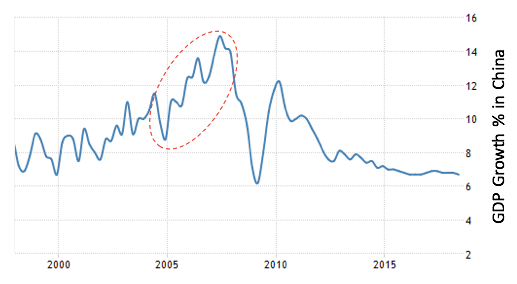
I moved back to the US at the end of 2007, feeling lucky in my timing to have been on the ground for China’s peak economic boom. But turns out, my timing was wrong. Turns out, China was just getting started.
清单体 (or Chinese for “listicle”)
On 8/8, at 8pm, here are 8 observations about China’s economy, with a specific focus on its tech economy, that make China the most fascinating tech market in the world. And more importantly, I hope they help show why the past decade in China has been far more interesting than the period before that, and that the next decade will surely top this one.

(1) China has the largest middle class in the world
As mentioned above, China’s economic boom from 2004 to 2007 was truly a sight to behold. But far more meaningful and interesting to the entire world order has been the effect of that boom. Since 2007, China has more than tripled the size of its Middle Class, defined as those with more than $10,000 per year in disposable income.
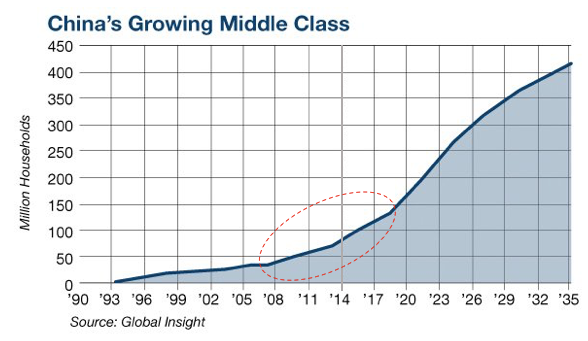
The echo of the economic boom has created the largest middle class in the world in China. And here’s why that matters to people all around the world: that growing Chinese middle class spent over $260 billion overseas last year, more than any other nation, yet only 5% of its citizens have a passport! Chinese consumers are set to reshape markets domestically and abroad.
(2) Cross border e-commerce is growing faster than domestic e-commerce
To further highlight how that growing China middle class will affect the world, remember that thanks to the Internet, they don’t even have to travel to flex their spending power. Over the past 5 years, the growth of cross border e-commerce (users in China purchasing goods from abroad) grew faster than domestic e-commerce. Cross border now makes up 7% of overall e-commerce spend, or more than $100 billion in annual revenue, as Chinese buyers are increasingly looking to buy higher quality products from overseas. The cross border market is expected to exceed $140 billion by 2021.
So even if they don’t plan to ever have a presence in China, businesses around the world should be thinking about the Chinese consumer.
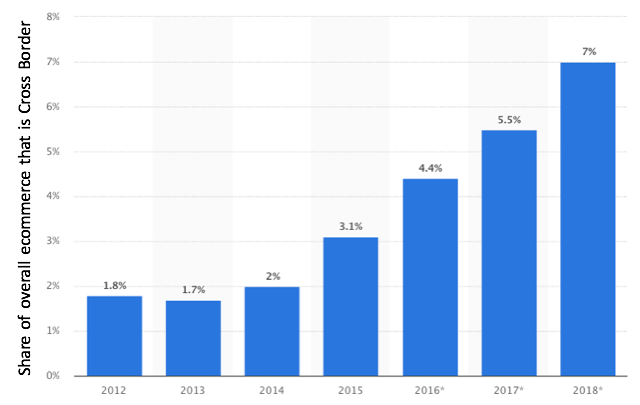
(3) E-commerce goes real world
China is the world’s leading e-commerce market, with over $1.1 trillion dollars transacted in 2017, more than twice that of the US. There are more than 500 million total online shoppers, and in the major metropolitan areas like Beijing and Shanghai, almost 90% of residents already shop online. While China e-commerce will still have very strong 20% annual growth for the next few years, it can be viewed as a maturing market.
So where are the new growth markets that commerce giants like Alibaba and JD.com, masters of the digital world, are looking at? They are back in the physical world. 2 years ago, Alibaba’s CEO Jack Ma coined the term “new retail” and the entire industry has been pushing online experiences into offline locations ever since. Alibaba has already opened 46 of their own grocery stores, under the brand Hema, across 13 cities. This year, they are averaging a new store opening every 6 days. Not to be outdone, JD.com recently opened its first grocery store in Beijing, called 7Fresh, with dozens more set to launch. And they’ve partnered with franchisees to open more than a thousand convenience stores, some of them fully automated with no staff required, and have set a staggering goal of launching 1,000 new stores per day by year end. Not only is physical retail not going away in China, it’s more strategically important than ever.

(4) Big opportunities in small cities
When Shanghai based Pinduoduo raised $1.6 billion in its IPO two weeks ago, it brought to light a number of interesting trends such as the power of the WeChat ecosystem and the engagement of social, discovery-based shopping. But the most interesting trend surfaced was the huge opportunity in China’s rural markets.
Chinese companies have historically targeted the major metropolitans, known as Tier 1 and Tier 2 cities. But the rural areas, known as Tier 3 and Tier 4 cities, have experienced tremendous growth in population, Internet penetration, and most importantly disposable income, which is up more than 36% the past 5 years. Goldman Sachs estimates that rural cities will account for 71% of new online shoppers over the next few years. Pinduoduo has capitalized on this trend brilliantly with nearly two thirds of its customers coming from rural cities. More companies will surely follow.
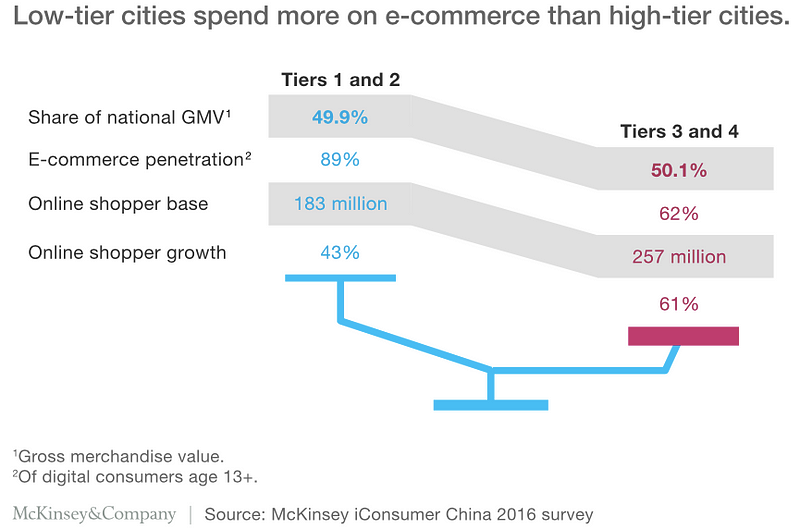
(5) There’s an entire new Internet inside WeChat
The Apple App Store, launched in 2008, reached 100,000 apps in its first year post launch. A year after Tencent launched its Mini Program last January (which are HTML5 based third party apps inside of WeChat’s mobile app), it already had 580,000 apps / programs, a mark that would take Apple 5 years to reach. Last month, they hit 1,000,000 mini programs as the pace of growth has accelerated.
Tencent is projecting that 400 million users will be using WeChat mini programs every single day by the end of this year, across every category imaginable supported by a rich ecosystem of service providers. For example, 60% of Pinduoduo’s users already access the service through their mini program.
Through unique features of their mini programs, WeChat has totally nailed 3 of the toughest challenges of building an app:
- Onboarding. Everyone is already logged in and uniquely identifiable which makes onboarding easy.
- Distribution. Users have full access to their WeChat contacts to share content, including the entire mini app.
- Payments. Users can immediately purchase through WeChat Pay with no additional setup.
The programs may by mini, but their impact will not be.
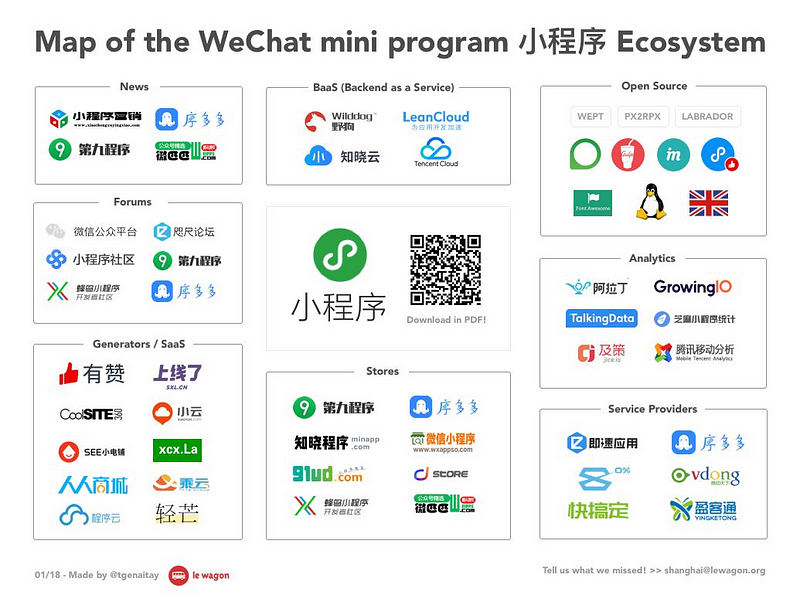
(6) To B-AT, or not to B-AT; That is the question
On August 5th, 2005, Baidu when public on the NASDAQ and watched its stock shoot up 354% by end of day, a historic pop that’s been the largest first day gain in the past 18 years. The stock continued its meteoric climb over the next 9 years until November 2014, when it lost momentum and has been relatively flat since. Almost at that exact same time in September 2014, Alibaba went public with the largest global IPO ever. While very different products, Baidu and Alibaba share one key similarity: they both drive significant revenue from digital advertising. And while you might think that Baidu does more advertising revenue (given our experience with Google’s dominance in the US advertising market), you’d be surprised to hear that the number one digital advertiser in China is none other than Alibaba.
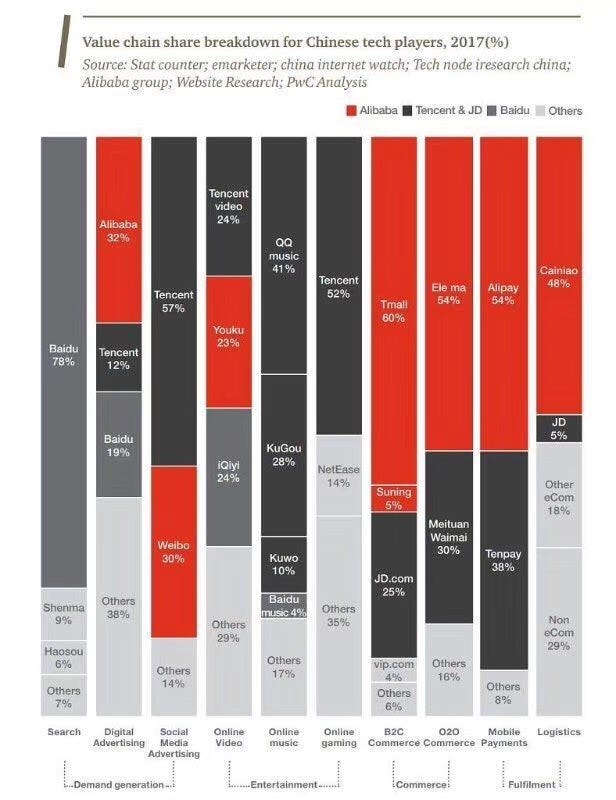
How can that be? Well from the very beginning, Alibaba has blocked Baidu from indexing its shopping content and kept that proprietary to Alibaba’s own search service and monetized that traffic itself. Contrast that with Google, who captures over 75% of all retail shopping search ad revenue. That’s a significant chunk of revenue enjoyed by the leading US search engine (Google) that the leading China search engine (Baidu) does not have access to. As e-commerce ad revenue continues to outpace general search ad revenue, Baidu’s own revenues will likely erode.
So while the A (Alibaba) and the T (Tencent) are stronger than ever in the BAT lineup, the B (Baidu) is facing an uncertain future. Does that mean we may soon see TAT (Toutiao Alibaba Tencent), DAT (Didi Alibaba Tencent), MAT (Meituan Alibaba Tencent) or some other grouping? Time will tell.
(7) China is skipping past the rest of the world in payments and AI
Consumers in emerging markets like China often skip over entire generations of platforms. For example, the US went from VHS to DVD as the platform for mainstream physical media evolved. China however skipped VHS and went straight to DVD because DVD was already an option by the time they needed mainstream physical media. In China, there just was never a VHS era, or a wired Internet era, or a desktop PC era, or a CRT television era — these platform generations were all skipped. This skipping phenomenon happens because as emerging markets develop a consumer need around a platform, the consumers pick the best solution available at that time instead of following the same progression of the platform in mature markets.
We’re witnessing two platform skips right now in China around payments and computing that are particularly interesting because the skip is not just to the latest solution from the US or other established market. Instead, the skip is to solutions more advanced than anything the rest of the world has. The skip is straight to the front of the pack.
For payments, China is in the midst of skipping credit cards as the dominant payment platform and jumping straight to mobile payments (namely Alipay and WeChat Pay). Mobile payments in China is already a $16 trillion dollar market, or approximately 100 times bigger than the US. To illustrate the prevalence of mobile payments, I was in Beijing last week and picked a restaurant that clearly stated they accepted credit cards. However when it was time to pay, I had to wait 15 minutes because their credit card reader had run out of batteries from lack of use. China isn’t about to skip credit cards, and therefore the US, in payment technology. It’s already happened.
For computing, mature markets still primarily rely on computer assisted tasks where a computer supports a human, who is the decision maker. However China is in the midst of skipping this computer assisted model and jumping straight to Artificial Intelligence driven decisions. China’s President Xi Jinping has set a goal of making China the global leader in artificial intelligence by 2030. Part of it is out of necessity as serving the sheer size of China’s population requires intelligent automation with throughput far beyond manual, human efforts. But part of it is also opportunistic as the impact of China’s AI economy is expected to be worth hundreds of billions of dollars. Judging by the pace of fundamental AI research going on in China, where they are now publishing more papers than any other country in the world, China looks to be well on their way towards another platform skip.
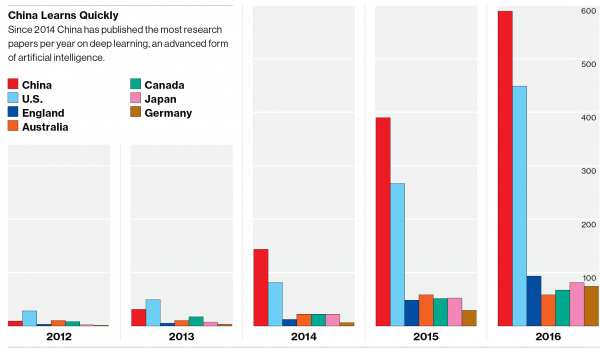
(8) The golden age of China startups is upon us
A few weeks ago, I wrote a blog post on the State of Consumer Startups, focused mainly on the US. My conclusion was that the golden age of startups was between 2009 and 2012, during which iconic consumer companies were being founded consistently each year. And since then it’s been far harder to break out as a consumer entrepreneur. But is the same true for China?
In the chart below, I’ve queried Crunchbase for consumer and enterprise China unicorns (consumer or enterprise startups that have achieved a billion dollar valuation) since 2005 and plotted them by their founding date. One thing to note is that you have to ignore 2014 onwards because companies take time to mature and grow in value so there will obviously be fewer unicorns in recent years. However the up-and-to-the-right trend from 2007 to 2014 is clear. There has been increasingly more breakout startups in China, both in consumer and enterprise, since 2007. The echo of the economic boom in China’s GDP from 2004 to 2007 has created the raw ingredients for great startups to emerge now, and emerge they have.
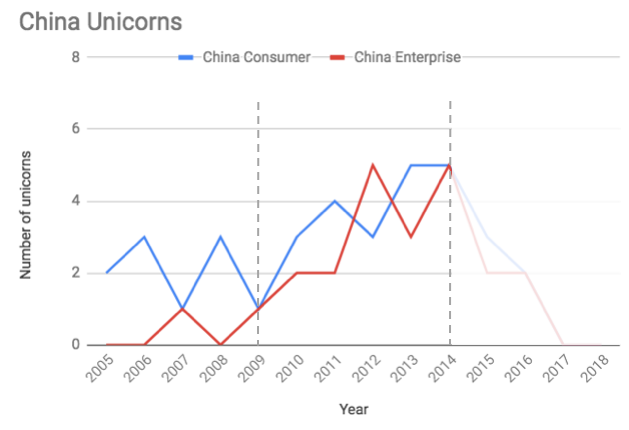
Epilogue
“Google decides to return to China, we are very confident we can just player-kill and win again”
Robin Li, CEO of Baidu
Imagine for a moment that the Chinese government welcomed all US tech companies into the market with open arms and a level playing field. What would happen?
Ecommerce companies would be dealing with a Chinese incumbent who on their busiest shopping day last year (November 11, 2017) delivered a package only 12 minutes after it was ordered, and is investing $16 billion to create a logistics network that can deliver any package in the country within 1 day. Social networking and communication companies would be dealing with a Chinese incumbent that has 83% mobile penetration in China, and can be used for everything from chatting with your friends to paying your utility bills. The China Search incumbent has 70% market share, the China Ride Sharing incumbent completed 7.5 billion rides last year, the China On demand Delivery incumbent averaged 18 million daily orders. These numbers aren’t just impressive for companies in China — they are some of the most eye popping, impressive business metrics for any company in the world.
On August 1, it was widely reported that Google was planning on re-entering the China market with a censored version of its search engine, codenamed Dragonfly. Google had previously operated in China until 2010, when it withdrew due to ethical concerns around censorship. Just a week earlier on July 25, Facebook was briefly granted a license to open its first subsidiary in the Zhejiang province, only to have that license rescinded after a few hours. Amazon has struggled to find success in China with less than 2% e-commerce market share, but has continued to aggressively recruit in the country with hundreds of job openings. If at first you don’t succeed, try again right? It’s clear that the China market opportunity is too big and important for these US tech giants to ignore, but will they ever be successful in China?
That’s yet another question that will continue to make China fascinating for years to come.
Write by
Eric Feng
Back at Kleiner Perkins. Previously CTO of Flipboard, Founder of Erly, Founding CTO of Hulu, Microsoft Research alum.